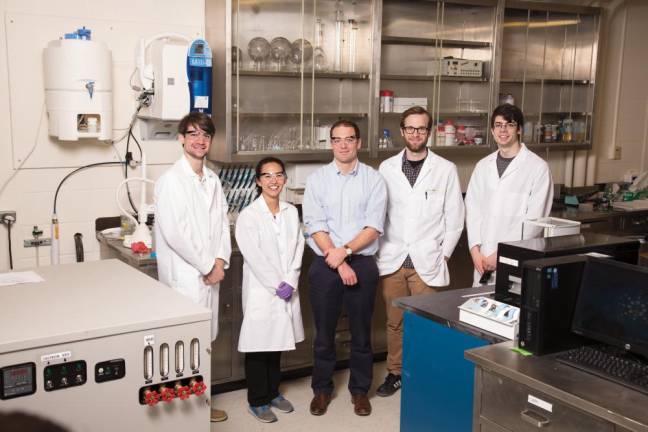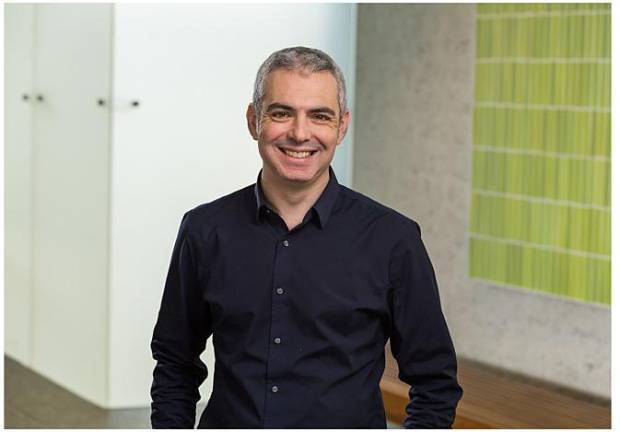Columbia Receives $4.8 Million for ‘High Risk, High Reward’ Research
The funding is split between two engineering projects that could boost clean energy



For the past six years, chemical engineer and Columbia University Professor Dan Esposito has been hard at work on technology thinner than a single strand of hair — less than one-hundredth as thin, to be more precise. Now, that technology is playing a role in what could become a new type of electrolyzer for creating clean fuel, if Esposito’s research into the feasibility of implementing the ultrathin membrane in that hydrogen-producing device proves successful. It’s a project, he explained, that’s “high risk, high reward.”
“We have a ways to go,” Esposito said. But if he and his team can get the project to work on a large scale, they’d be optimistic that “this is something that can truly have an impact.”
It’s one of two research projects — the other, led by Co-Director of the Columbia Electrochemical Energy Center Dan Steingart, investigating a way to store renewable or other forms of energy — to receive special grants totaling over $4.8 million earlier last month, as announced by Columbia University alumnus Rep. Jerrold Nadler. The money comes from the Advanced Research Projects Agency-Energy (ARPA-E), a U.S. Department of Energy agency that funded 68 projects in total at the start of this year as part of its OPEN initiative, which supports “disruptive technologies” in a range of technical fields.
“This type of investment in research and innovation and collaboration among academia and government will go a long way toward advancing a more sustainable energy future for all,” said Shih-Fu Chang, interim dean of Columbia Engineering, in a statement.
An Electrolyzer Like Never Before
Esposito’s project — dubbed “high capacity electrolyzers based on ultrathin proton-conducting oxide membranes” — was awarded over $3.3 million from ARPA-E. As the principal investigator, Esposito is looking into innovating the electrolyzer, which splits water into its two components, hydrogen and oxygen. The hydrogen produced could be used as a fuel in the shipping industry, as a chemical for fertilizers and in metal manufacturing — all as an alternative to less environmentally-friendly fuels and fuel components.
“We all know that we need to move away from carbon dioxide and other greenhouse gasses, such as methane, because of the climate issues that those are causing,” Esposito said. “An alternative fuel that can substitute for the hydrocarbon fuels that we rely on today is hydrogen.”
Water electrolysis itself is nothing new, but existing methods for creating hydrogen via this process aren’t particularly cost-effective, clocking in at three to six times more expensive than another method involving steam and methane. Esposito’s research has potential to improve performance while also decreasing cost, thanks to the ultrathin membrane.
The project is still in its infancy, even though research into some of its components — like the special membrane — has been long in the making. Esposito and his team of around eight researchers, three of whom are Columbia University students, will be attempting ultimately to create an electrolyzer the size of a mini fridge. The guiding principles of efficiency, durability and “throughput” (or the ability to achieve greater fuel production) will illuminate their course over the next three years, the lifespan of their project, which is funded solely by the ARPA-E grant.
“We want to get more bang for our buck,” Esposito said. “We want to make these reactors produce the desired fuel at a higher rate, we want to do that more efficiently than the electrolyzers can today and we want to make sure that they can do this for a ten-year time period without experiencing a decrease in the performance.”
A Battery Mash-Up
The other research project underway at Columbia — called “lithium-ion bobbin cells for grid scale energy storage” — also has big potential, according to primary investigator Steingart. The project is so intuitive, he explained, that it’s surprising it hasn’t already been tested. “It’s not rocket science,” he said.
Steingart’s research will combine the existing “bobbin cell” geometry commonly found in AA batteries with lithium-ion chemistry to create a different kind of battery — and assembly doesn’t need to be as complex as for other battery-making techniques. “It looks like you’re making cat food,” he said of the process.
The resulting technology could be used as an alternative to traditional generators to store excess renewable energy, like solar or wind power, of which availability fluctuates depending on environmental conditions. “The goal is to support the decarbonization of the grid in the fastest way possible,” Steingart said. Prior ARPA-E grants have already proven valuable in Steingart’s experience; he’s launched two companies for technology developed with previous funding from the agency.
This time around, Steingart’s working with a handful of others, including students, to complete the research in three years — an impressively quick timeline, he noted, at least in the world of academia. “It’s a single PhD cohort,” Steingart said.
“This type of investment in research and innovation and collaboration among academia and government will go a long way toward advancing a more sustainable energy future for all.” Interim Dean of Columbia Engineering Shih-Fu Chang